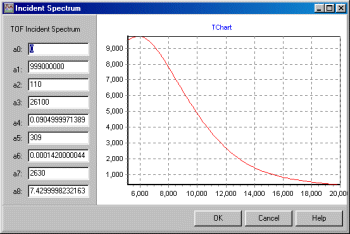
|
Much of the following is based on advice from Brett Hunter
using Argonne TOF data. Mileage may vary depending on the
nuances of your data.
It is assumed that you have the TOF Constants information:
|
|
The Incident Spectrum information is
inserted into Rietica via the Model, Histograms menu
then selecting the Incident Spectrum button
|
|
The Zero, Difa and Difc constants are inserted into Rietica
via the Model, Histograms menu. On a normal refinement,
Difa and Difc would not be refined and would normally be
obtained by running a standard such as NBS/NIST Silicon.
|
|
The alpha0, alpha1, beta0, beta1 constants are inserted via the
Model, Sample menu.
|
|
From Brett Hunter: 1) DIFC, DIFA, ZERO are never refined during a normal course of refinement - only when calibrating (no lattice parameter refinement in that case). They correlate too strongly (1-to-1) to the lattice parameters, and should, for TOF, be true instrument parameters. 2) the alpha's and beta's should also be instrumental, unless you believe that you have asymmetry, such as a compositional variation in your sample. Usually only alpha-1, beta-0 and beta-1 are non-zero in any case. For HRPD-ISIS the alpha's are larger than say SEPD-IPNS due to the sharp rise and high resolution. You may in the case of the alpha-1 get a large variation (with little or no improvement in fit) for HRPD-ISIS. As it doesn't affect anyhting - don't worry. 3) you may near the end of a refinement turn them on alpha/beta's to see what happens - sometime a small improvement in fit is obtained. Unless you believe there is a physical reason for it, don't change them from the instrumental values. 4) if you are far from the ideal peakshape/fit, a suggestion is to keep sig-1 fixed at a readonable value, say 10-15. Fix up as many of the other problems (such as lattice parameters etc), then refine sig-1. After that try gam-1. Sometimes it is also best to put it further off a zero value, say at a value of 10, and then refine, that to refine directly from 0.0. After that you can try sig-2 and gam-2. 5) If your instrumental fit has no sig-0 and gam-0 components (eg HRPD-ISIS), then don't bother refining them until the end, if at all.
|